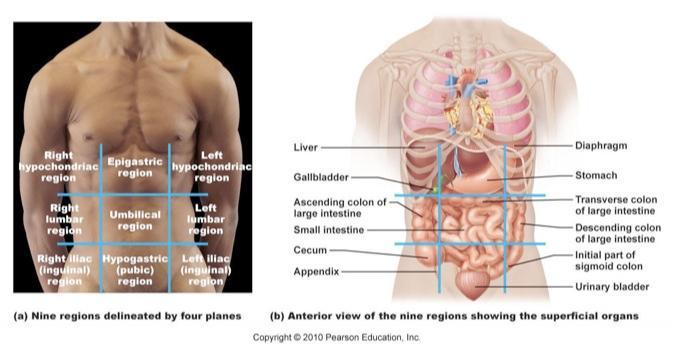Anatomy:
The study of the structure of body parts and their relationships to one another.
Physiology:
The study of the functions of the body, or how the body parts work and carry out their life sustaining activities.
Principle of Complementarity:
What a structure can do depends on it's specific form. STRUCTURE DETERMINES FUNCTION. (This is the theme of the course)
CATABOLISM (metabolism):
Breakdown into simpler substances
ANABOLISM (metabolism):
Synthesis of more complex substances from simple ones.
Necessary Life Functions:(8 total)
1. MAINTAINING BOUNDARIES: Cell Membrane, integumentary system
2. MOVEMENT: activities promoted by the muscular system
3. RESPONSIVENESS (irritability): sense changes and respond to them
4. DIGESTION: breakdown of ingested food into simple molecules for absorption
5. METABOLISM: all chemical reactions within body cells
6. EXCRETION: removing wastes
7. REPRODUCTION: Creating new daughter cells or offspring
8. GROWTH: Increase in size or cell number
What are the SURVIVAL NEEDS for the body?
Nutrients, Oxygen, Water, Normal Body Temperature, Atmospheric Pressure.
Name the different levels of Structural ORGANIZATION that make up the human body and explain their relationships.
Chemicals (atoms, molecules), Cells, Tissues, Organs, Organ Systems, Organisms.
Define HOMEOSTASIS and explain its significance:
HOMEOSTASIS: is the ability to maintain relatively stable internal conditions even though the external conditions are continuously changing.
It is a DYNAMIC EQUILIBRIUM, where internal conditions vary, but always within relatively narrow limits. Variables are controlled and it involves a RECEPTOR (sensor that monitors the environment and responds to changes), a CONTROL CENTER (determines set point and level or range which the variable is to be maintained at), and an EFFECTOR (provides means for the control centers response to the stimulus with negative or positive feedback). (Ex. Blood pH 7.35-7.45 ideal 7.4)
How do NEGATIVE and POSITIVE FEEDBACK maintain body homeostasis?
NEGATIVE FEEDBACK: (Most Homeostatic controls are negative) The output shuts off the original effect of the stimulus or reduces its intensity. These mechanisms cause the variable to change in a direction OPPOSITE to that of the initial change, returning it to its "ideal" value. Like a thermostat. (Ex. Blood glucose levels)
POSITIVE FEEDBACK: The result or response enhances the original stimulus so that the response is accelerated. It is POSITIVE because the change that results proceeds in the same direction as the initial change. (Ex. more oxytocin causes more uterine contractions that cause more oxytocin release that causes more contractions, etc.)
Describe the relationship between HOMEOSTATIC IMBALANCE and disease.
results in disease or aging, due to the body's inability to maintain a stable environment.
Describe the ANATOMICAL POSITION.
Body erect, arms at sides, legs together, palms face up. (Allows proper orientation of the parts of the body that gives us one directional reference point)
Use correct anatomical terms to describe BODY DIRECTIONS and REGIONS.
DIRECTIONAL TERMS: allows us to explain where one body structure is in relation to another.
SUPERIOR: Above ANTERIOR: In front of
INFERIOR: Below POSTERIOR: Behind
MEDIAL: Toward the midline
LATERAL: Away from the midline (sides, edges)
PROXIMAL: Closer to the main part of body (used with appendages)
DISTAL: Farther away from the main part of body (appendages)
SUPERFICIAL (external): Toward surface
DEEP (internal): Away from surface
Use correct anatomical terms to describe BODY PLANES and SECTIONS.
FRONTAL (coronal): Divides into front and back halves (Like a CT Scan)
SAGITTAL: Divides into left and right halves (midsagittal divides into equal left and right halves)
TRANSVERSE (axial): Divides into top and bottom halves. (See Pg. 14)
Locate the name the MAJOR BODY CAVITIES and their SUBDIVISIONS, and list the MAJOR ORGANS contained within them.
CRANIAL: Contains Brain
SPINAL: Contains Spine
DORSAL: Made of Cranial and Spinal Cavities
VENTRAL: Made of Thoracic, Abdominal and Pelvic cavities.
THORACIC: Contains Lungs and Heart, Bounded Posteriorly by Diaphragm.
ABDOMINAL: Contains Digestive Organs, Spleen.
PELVIC: Contains Urinary Bladder, Reproductive Organs, some Digestive Organs. (See pg. 15)
Describe the specific SEROUS MEMBRANES and indicate their common function.
(like a fist in a balloon) A double layered membrane with fluid in the cavity between layers. It allows organs to move without friction (heart, lungs, etc.)
Serous Membranes in Ventral Body Cavity:
PARIETAL PLEURA: Lines the walls of the thoracic cavity
VISCERAL PLEURA: Covers Lungs, pleural cavity is found between parietal and visceral pleura
PARIETAL PERICARDIUM: Sac around the heart
VISCERAL PERICARDIUM: Also called epicardium, covers heart with pericardial cavity in between
PARIETAL PERITONEUM: Lines walls of abdominal cavity
VISCERAL PERITONEUM: Covers abdominal organs
Name the FOUR QUADRANTS of the Abdominopelvic cavity and list the organs it contains.

Name the NINE REGIONS of the Abdominopelvic cavity and list the organs it contains.
